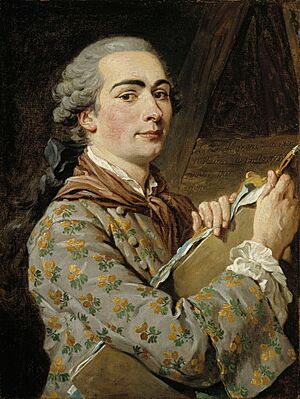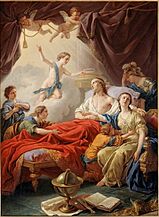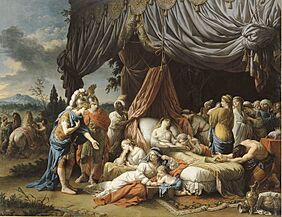Louis-Jean-François Lagrenée facts for kids
Quick facts for kids
Louis-Jean-François Lagrenée
|
|
|---|---|

Self-portrait, 1750s
|
|
| Born | 30 December 1724 Paris, France
|
| Died | 19 June 1805 (aged 80) Paris, France
|
| Other names | Lagrenée the elder |
| Known for | Painting |
| Movement | Lagrenée's work was Rococo in style, directly influenced by the Bolognese School of painting. |
Louis-Jean-François Lagrenée (born December 30, 1724 – died June 19, 1805) was a famous French rococo painter. People called him Lagrenée the elder. He was a student of the well-known artist Carle van Loo.
In 1749, he won a big art prize called the Grand Prix de Rome. This prize allowed him to study art in Rome. In 1755, he became a member of the Académie royale de peinture et de sculpture (Royal Academy of Painting and Sculpture). His younger brother, Jean-Jacques Lagrenée, was also a painter.
Biography
Louis-Jean-François Lagrenée was born in Paris, France. From a young age, he showed great talent for drawing and painting. The French Royal Academy offered art classes to the public. These classes helped the Academy find talented young artists.
Lagrenée was chosen for a special program called the École royale des élèves protégés. This program gave free lessons and a small payment to students for three years. It prepared them for the Prix de Rome competition. After finishing this program, he won the Grand Prix de Rome in 1749. His winning painting was Joseph interpreting the dreams of Pharaoh, but it is now lost.
While studying at the French Academy in Rome, he became very interested in Baroque painting. He especially loved the work of artists from the Bolognese School, like Guido Reni and Francesco Albani. Later in his life, people even called him 'the French Albani'.
After returning from Rome in 1753, he painted a large work called The Abduction of Deianira by the Centaur Nessus. This painting is now in the Louvre museum. When he finished it in 1755, it helped him become a member of the Royal Academy. Everyone voted for him. By this time, he was already quite famous.
In 1758, when he was 33, he married Anne-Agathe Isnard. She was 16 years old. They were still married when he passed away in 1805.
Later Career
Lagrenée's career in Paris grew very well. He painted many works for important people and a new group of wealthy art lovers. He also regularly showed his paintings at the Paris salon exhibitions.
His fame reached Empress Elizabeth Petrovna of Russia. In 1760, she made him the director of the Imperial Academy of Arts and her main court painter. After only two years in Russia, he came back to Paris. He became a professor and rector at the Royal Academy.
From 1781 to 1787, he lived at the Villa Medici in Rome. There, he was the director of the French Academy. He later returned to Paris for the last time. He was given an important job as an honorary curator-director at the Louvre museum.
On July 15, 1804, Napoleon I made him a Knight of the Legion of Honour. This was a very high award. Lagrenée died the next year.
Works in Public Collections
Here are some of Louis-Jean-François Lagrenée's paintings that you can see in museums:
- Paris, musée du Louvre : The Abduction of Deianira by the Centaur Nessus (1755), Mercury, Aglaura and Herse (1767), Psyche Surprises Cupid Asleep (1768), The Death of the Wife of Darius (1785).
- Stockholm, Nationalmuseum : Mars and Venus Surprised by Vulcan (1768).
- Los Angeles, Getty Center : Venus and Mars, an Allegory of Peace (1770).
- Detroit Institute of Arts : Pygmalion and Galatea (1781).
- Palace of Fontainebleau : The death of the Dauphin, surrounded by his family (1765).
- Lyon Cathedral, Saint John the Evangelist on the Island of Patmos (1758).
Gallery
Notable Students
Some of the artists who studied with Louis-Jean-François Lagrenée include:
- Antoine-Denis Chaudet (1763–1810)
- Lagrenée the Younger (his brother)
- Pierre Peyron (1744–1814)
See also
 In Spanish: Louis Jean François Lagrenée para niños
In Spanish: Louis Jean François Lagrenée para niños



